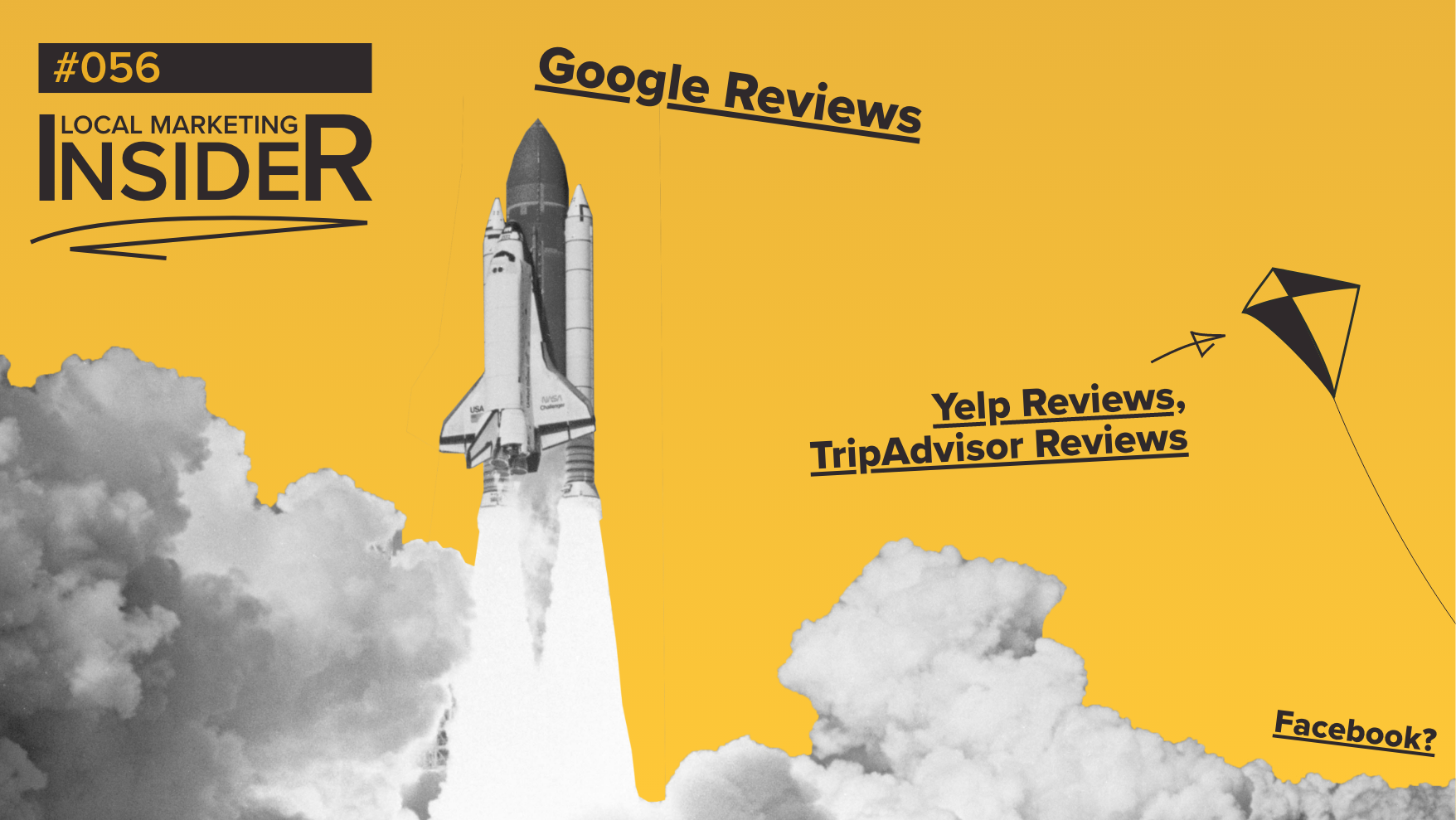-
Products
TechnologyManaged Services
- Resources
- Pricing
- Company
2023 Reviews Trends to Help You Make Smarter Reputation Management Decisions

Hey! Welcome to Local Marketing Insider where 9,000+ local marketing professionals get better at reputation strategy & more with insights delivered 2x a month.
Read the other articles. Subscribe.
It has been a minute since I’ve done a deep dive into the latest reviews research, so this week I did some digging. Everything referenced in the article is from 2021 or newer.
These are my “relevant-in-2023” review trends and concepts that are worth paying attention to.
TREND: Google is Strongly on the Rise
Google’s use as a review site has grown in the last 3 years, from 63% to 81% to 87%.
Consumer preferences continue to trend toward Google as a dominant influence on the review market.
A few niche strongholds remain, with Yelp still relevant in Food/Drink and TripAdvisor in Travel. Beyond specific industry use cases, no review site comes close to the utility and trustworthiness of Google.
What’s surprising is the rapid decline of Facebook, consistently losing market share each of the last 3 years. Its trust percentage, averaging in the single digits, maxes out at 14% in entertainment & beauty (compared to Google consistently in the 60% range). Worse, concerns about fake reviews on the platform are up 6%, acting as further evidence of its decline.
Prediction: Google’s introduction of visual tools, which are primarily focused on Dining and Retail, will take a chunk out of Yelp’s Food/Drink market share.
Data by Brightlocal.
TREND: Consumers Developing a “Playbook” to Identify Fake Reviews
Studies by both Brightlocal and Moz dedicated significant attention to customer perception of how they judge what is a real review and what is fake.
In response to what appears to be increased suspicion surrounding businesses attempting to game the system, consumers appear to be developing a playbook for how to feel out if reviews should be trusted.
Customers tend to suspect reviews could be fake if they contain:
Prediction: Following the AI buzz, the addition of “AI-sounding responses” will be added to the consumer trust litmus test.
OpenAI recently launched a classifier tool that can help distinguish between AI and human-written text. OpenAI notes the tool is “very unreliable” when analyzing blocks of text less than 1,000 characters, so the tool is likely of limited use for reviews.
Research by Brightlocal and SEMRush.
OBSERVATION: When the Stakes are Higher, Reviews are Worth More
In industries like healthcare, automotive, services (financial, legal, home), 50% of consumers view reviews as “very important,” and only about 15% believe they are of “slight” or “no” importance.
Compare that to retail and entertainment where 17% view reviews as “very important” and 43% note them as of “slight” or “no” importance.
When the stakes are higher– i.e., either the decision carries more weight toward a consumer’s well-being (healthcare vs. retail) or is of more monetary value (automotive vs. entertainment) – reviews are more valuable and influential.
Data from Brightlocal.
OBSERVATION: Google Values Review Volume for Rankings; Ratings More Valuable to Prospects
Analyzing 5,624 “business-oriented keywords” and their impact on Local Pack results, SEMRush found a clear review volume pattern between positions 1, 2 & 3.
This pattern was not the case with ratings.
Offering a counterpoint, a study by Moz of consumer behavior found that 36% of respondents view star rating as the most influential part of a review, over the number of reviews at just 10%.
The Association for Psychological Science released a research paper in 2017: Love of Large Numbers: A Popularity Bias in Consumer Choice. Analyzing Amazon reviews, the study found that review volume was more influential than rating, in part, because volume is viewed as a measure of popularity, while rating is perceived as more subjective.
My take: The research goes back and forth, never really providing a clear answer to which is more important: rating or volume. There is some additional context that I think is worth bringing up.
The way Google uses review content to determine rankings and the way consumers perceive this data to inform their decision-making should be considered independently, with slight differences.
For one, Google rankings rely just as much on review frequency as it does total review volume, which is not accounted for directly in the SEMRush data. Further, review volume and, to a degree, ratings vary significantly by industry - a review volume number that is competitive in solar is likely not competitive in automotive due to the differences in transaction volume.
On the consumer side, I think there is some base-level understanding that ratings can be variable. If the review volume is above a minimum respectable level, then 400 vs. 500 reviews is not a dealbreaker.
The other caveat: In some keyword situations (“best”, “top-rated”), Google is automatically filtering out businesses below a 4.0, so consumers are not even seeing a wide range of options.
Think about it this way: To rank in the Local Pack your goal needs to be at least a 4.0 (ideally 4.5-4.7) and your volume should outpace the local competition in your category.
For consumers, it’s a comparative calculation. First, your business needs to show up in the Local Pack (50% of clicks). For rating & volume, you should pass the viewer’s sniff test. This is the initial gatekeeper. Pass those two tests and your review content and responses need to hold up to reader instincts. If you pass all three tests then your business is very well set up to drive motivated, high-quality inbound inquiries.
Data by SEMRush, Moz and Association for Psychological Science.
TREND: Consumer Preference is Moving Toward New Search Experiences, i.e. Visual, and Google is Ready
Google’s launch of new visual experiences in maps talks about “vibe checks” and directly competes with TikTok & IG in providing new avenues for local discovery.
Yelp is still well-regarded in food/drink, but Google’s launch of visual search tools is focused on restaurants. As noted above, expect Google to eat away at Yelp’s market share.
Emerging are two types of search behavior: “I need it now” searching and “I may be interested in this in the future” discovery activity. Google still dominates “I need it now” searching, but TikTok, IG & Google seem to be the best positioned to support forward-looking discovery activity.
TACTIC: Local Business Squaring Up Against Listing Sites and Directories
Reviews, i.e. your volume+frequency+quality+response, account for 17% of local pack rankings, but just 5% of regular local search rankings.
The local pack absorbs 50% of clicks, with 23% going to ads, meaning 83% of clicks go to content above the regular local search rankings.
Reviews and map pack placement are reserved for local businesses. This is a huge advantage for businesses over listing sites, which have to compete in the regular organic search rankings or pay for ad space.
It’s a common debate amongst local businesses whether or not to go all in on Google or divert some resources to industry-specific reviews or listing sites.
With a little Google searching you can make an informed decision specific to your industry and geo.
The goal is to identify if an industry-specific directory or review site has domain authority of its own by seeing if it shows up for your primary keywords.
Here’s a little insight from Widewail CEO, Matt Murray, “I always counsel local businesses to take a look at the historical performance of their vertical-specific review sites through the lens of website analytics. In other words, just as an example, before a car dealer worries about Yelp, does Yelp really provide any appreciable amount of traffic to the dealer site? If a referring domain is <1% of total web traffic it likely should not be considered a priority.”
Data by Whitespark
TREND: The Search for Value
Inflation, layoffs, down stock market, high mortgage rates – regardless of their material impact on each person’s day-to-day life, the white noise of a less-than-rock-solid economy impacts the behavior and preferences of consumers. Lately, we are seeing trends around a return to value. An increased focus on durability over just cost.
A Whitespark study talks about how keywords in reviews are the 2nd most important ranking factor.
Looking broadly at the environment of the day, keywords like “durability,” “longevity,” and “reliability” have unique relevance and could drive more value for your business in the right context.
Our Campaigns functionality is great for sourcing reviews with specific keywords.
Insight by Whitespark and Think with Google.
TREND: Altruism and Demographics Influence Reviewer Motivation
54-73% of reviewers are “likely” or “very likely” to be motivated to leave a review in these circumstances:
Interestingly, women are 13% more likely than men to leave a positive review of a business that is owned by a community they are either a part of or associated with.
This concept of “shopping based upon shared values” is a broader phenomenon in the market. Brand loyalty is on the decline with consumers displaying more willingness to explore new brands based upon unique characteristics like values alignment.
Research by Brightlocal and Think with Google
TREND: Serious Jump in Incentivizing Reviews
One of the largest jumps from the 2022 to 2023 Brightlocal survey is how many people experienced an incentive offer tied to a review request. This seems to be a natural evolution as more businesses take reviews seriously and attempt to find new ways to improve performance.
But, incentivizing reviews requires precision to execute legally.
Incentivizing reviews is not problematic in all its forms, but in practical terms, it is not always allowed.
As I understand it (insert disclaimer: shocker, I’m not a lawyer), you are legally allowed to incentivize reviews if you disclose that a review has been incentivized anywhere you post it online.
The challenge is, Google does not have any functionality to add such a disclosure and therefore it is against its policy to incentivize any reviews. This policy is in direct response to guidance from the FTC.
Since October 2021, the FTC has been taking a more serious stance on customer protections around reviews.
Illegal review practices invite potential fines from the FTC, and if you are suspected of below-board review activity by Google, they will simply delete all of your reviews without recourse.
Generally speaking, all review platforms have a similar privacy policy.
Two situations where incentivizing is fine: If you’re generating product reviews that live with a disclaimer on your site and if you’re generating video reviews and publishing a notification with your social post or ad.
Insight from Brightlocal and the FTC.
If you've made it to the end, congratulations.
This got a bit out of hand but, damn, was it fun to write.
See you in 2 weeks - Jake, Marketing @Widewail
I’m the Director of Marketing here at Widewail, as well as a husband and new dad outside the office. I'm in Vermont by way of Boston, where I grew the CarGurus YouTube channel from 0 to 100k subscribers. I love the outdoors and hate to be hot, so I’m doing just fine in the arctic Vermont we call home. Fun fact: I met my wife on the shuttle bus at Baltimore airport. Thanks for reading Widewail’s content!
Bite-sized, to-the-point, trend-driven local marketing stories and tactics.
Automated Review Generation
Video Testimonial Generation

Maintain Accurate Listings

Private Surveys
Review Response Managed Services
Social Media Engagement Services
©Widewail 2025.
U3GM Blog Post Comments